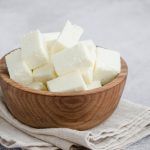Methi paratha is the traditional Indian flatbread made with fresh Methi leaves known as fenugreek. Delightfully seasoned with the benefit of good health, it has entered a special place in numerous Indian breakfast menus. Packed full of nutrients and taste, this paratha will – start your day in the best possible way.
Methi Paratha is one of the best Indian breakfasts and a healthy cover for simple paratha, prepared with fenugreek leaves and whole wheat flour. Methi Ka Paratha isn’t only nutritional and wholesome but also relatively easy to prepare. It may be enjoyed as a light snack during the evening also. It goes well with masala tea or plain curd and achaar. Among the numerous dishes that we make out of this seasonal delicacy are Methi parathas. The finely cut Methi leaves are mixed into wheat flour with salt, spices, and some oil to make a dough and are also rolled and cooked on the tawa until it turns golden brown. Methi paratha is a savor’s delight; it’s also enjoyed with salad, raita, or chutney.
What is Methi, and Why is it Good for You?
Methi, or fenugreek leaves, is a green lush vegetable considerably used in Indian cuisine. Known for its slightly bitter yet sweet flavor, Methi is a full pack of nutrition. It’s rich in iron, vitamins, and antioxidants that support overall health and fitness. Including Methi in your diet can enhance digestion, boost immunity, and promote healthy skin and hair.
Methi has many health benefits, specifically in controlling blood pressure and cholesterol. Methi seeds and dried-up Methi are also largely used. Utmost curries contain a Methi addition because it adds flavor and scent. Methi leaves have vast benefits. It’s veritably rich in salutary fiber, protein, iron, manganese, and magnesium. New mums are suggested to eat Methi periodically to increase their breastmilk. It can also be added to boost testosterone for men. According to Wiki, Methi has also been used in Turkish, Iranian, Georgian, and Egyptian cookeries too.
What’s Methi or fenugreek Paratha?
Methi paratha is an Indian flatbread prepared using fresh fenugreek leaves, whole wheat flour, and spices. Methi paratha is a tasty and healthy breakfast.
It can be served with seasonings similar to cilantro chutney. Methi is a package of nutrition; Methi paratha provides a healthier replacement for traditional paratha.
Nutritional Profile of Methi Leaves:
- Rich in Iron: increase hemoglobin levels.
- High in Antioxidants: boosts immunity.
- Packed with Vitamins: source of Vitamin A, Vitamin C, and Vitamin K.
| Nutrition Facts | |
| Wholesome Methi (Fenugreek) Paratha | |
| Serving Size 2g | |
| Amount per Serving | Daily Value |
| Calories | 100-200 |
| Fat | 15g |
| Saturated Fat | 2g |
| Sodium | 299g |
| Potassium | 364g |
| carbohydrates | 56g |
| fiber | 10g |
| sugar | 1g |
| Protein | 16g |
| calcium | 51g |
| iron | 6g |
5 Amazing Health Benefits of Methi Paratha
Fenugreek, or Methi, is packed with fiber, it aids digestion and helps regulate blood sugar situations. This fiber content also imparts a feeling of wholeness, potentially lowering binge eating and promoting weight loss. Also, Methi is rich in antioxidants and is anti-inflammatory, contributing to a healthier cardiovascular system.
Methi leaves are scientifically proven to drop blood sugar and cholesterol conditions. The leaf of the fenugreek contains numerous vitamins and minerals. Fenugreek leaves fall in the list of the healthiest green leafy vegetables.
They’re also good for women having PCOS. Especially, it’s anti-diabetic and anti-carcinogenic. The benefits of enjoying Methi paratha are:
1. Control blood sugar: Fenugreek may regulate blood sugar situations.
2. Increase Metabolism: fenugreek may profit the metabolic rate, which helps in burning off calories.
3. Low in calories: Methi paratha can be a low- calorie option compared to other foods, hence a good option for people wanting to reduce calorie input.
4. Anti-inflammatory: Fenugreek is an anti-inflammatory and may be helpful for conditions similar as arthritis. It also helps have healthier hair and skin.
5. Reproductive health: Regulate menstrual cycles and ease symptoms of PMS. It also aids in the making of breastmilk.
Fenugreek, the primary component in Methi paratha, provides many health benefits.
Why is Methi Paratha Perfect for Breakfast?
Methi Paratha is perfect for a boxed lunch or breakfast.
Methi Paratha can be a precious addition to a balanced diet due to its nutrient profile. It provides essential vitamins and minerals supporting overall health and vitality. Iron, in particular, is vital for maintaining energy and precluding fatigue.
The great breakfast dish is not only crisp and delicious but can also make us lose weight. Fenugreek or Methi is full of salutary fiber and can keep you full for a long time. This means that eating fenugreek or Methi paratha for breakfast can keep you full till lunchtime.
How to Make Methi Paratha?
| Methi Paratha | Fenugreek Paratha | |||
| A simple, healthy, whole-wheat flatbread seasoned with spices and Methi leaves or Fenugreek leaves | |||
| PREP TIME | COOK TIME | RESTING DOUGH | TOTAL TIME |
| 20 MINS | 20 MINS | 20 MINS | 1 HOUR |
| COURSE | CUISINE | SERVINGS | CALORIES |
| Appetizer, Lunch/Dinner, Main Course | Indian | 12 Parathas | 107 kcal |
| Equipment Kitchen Knife Cutting Board Griddle Cookware Wooden Roti Board and Rolling Pin Pan/Tava | Ingredients 1.5 Cups Whole Wheat Flour 3 Tbsp Corn Flour 1.5 Cup Fresh fenugreek leaves 1 Tsp Ginger Grated 2 Green chilly Finely Chopped 1/2 Tsp Coriander Powder 1/4 Tsp Red Chilli Powder 1/4 Tsp Turmeric Powder 1 Tsp Salt 1/2 Cup Lukewarm Water 1 Tbsp Oil 2 Tbsp Oil For brushing / shallow frying parathas | ||
Ingredients You’ll Need:
- Fresh Methi Leaves: You need fresh Methi leaves. You can find it in the Indian grocery store.
- Whole wheat flour: You need to make dough and for dough you need flour. Use whole wheat flour, still, if you’re gluten intolerant, you can use multi-purpose flour. You can also use gram flour if you want to get crisp parathas.
- Spices: spices include grated ginger, finely minced green chilies, coriander, red chilli, and turmeric powder.
- Oil: To prepare paratha. The addition of oil in dough helps to bind the fenugreek leaves and other spicies well with flour.
Some people do add Kasuri methi in paratha. You may add it, but still, for the taste, scent and nutrition, fresh fenugreek is the finest.
Step-by-step directions:
- Pluck the Methi leaves from the stem, wash, and also dry. Also, hash them finely.
- In a vessel, add wheat flour, cornflour, coriander, red chili, turmeric, and salt together. Mix well, so everything is incorporated well. Now add Methi leaves, grated ginger, and green chilies. Now add water a little at a time and make a tight and firm dough. Now add 1 tablespoon of oil and knead the dough. Cover it and let it sit for 20 mins.
- Divide the dough into 12 equal portions. Make a smooth ball and also flatten it. Now start rolling and roll into 5- 6- inch circle.
- Toast the tava on medium heat. Place the rolled paratha on it. Flip the paratha once you start noticing bitsy bubbles on the face. Start applying oil on the top side, flip it again, and cook it by pressing it easily and gently using a spatula. Now apply some oil on the other side and flip it. Cook it properly by flipping the paratha 2- 3 times.
- Once cooked from both sides, remove it from Tava and keep it in the insulated pot, so that it stays warm. Also, cook all the paratha repeating same process.
Methi Paratha Variations to Try
You can make methi paratha in two ways. You can make a paste of fresh Methi leaves and also add to the dough. Another way is to use fresh leaves in the dough without making a paste. I believe making the paste is less nutritive as compared to direct leaves. It tastes good when we feel leaves on our taste palate.
Methi Roti vs Methi Paratha
Some people associate Methi roti as a commodity. Methi roti and paratha differ in no element, still the process of preparing them would differ slightly. For Methi roti, you’ll put the roti directly on heat so that the roti puffs up just like a normal ‘fulka’. For paratha, you will sear it on a tava or visage. The taste of paratha and roti would be a bit different, and Methi roti is a healthier option, as compared to Methi paratha.
Methi Paratha vs Methi Thepla
Another generally known Methi predicated flatbread is Thepla. Although Methi paratha and thepla are flatbreads having Methi as the main element, they differ. Methi paratha has wheat flour, methi thepla recipe on the other hand has yogurt in little volume.
Paratha is crisp, thepla is soft in general.
The only difference to making thepla is adding yogurt in the dough, for making Methi paratha you do not need to add yogurt at all. The traditional form of methi thepla recipe has a bit of sugar or jaggery, paratha does not have a single sweetener.
Tips for Serving and Storing Methi Paratha
Storing Tips
- While Methi seeds have fantastic shelf lives, fresh Methi does not last long. Still, it lasts for two weeks, if you store it in the refrigerator without washing. It lasts only a week if you wash it.
- Also, since fresh Methi is the whole factory pulled out of the soil, you are likely to find some dirt at the bottom. The simple way to store it’s to cut off the dirty root ends and throw them.
- Store the rest and rinse before each use.
Serving Tips
Just slightly cook the methi leaves. Cooking them makes the leaves release the water in them. Adding a little salt also ensures that nearly all the water in the leaves is out. This leads to a smoother dough that does not turn sticky. The dough retains its consistency and is super easy to handle.
- Methi Paratha needs to be cooked on a medium to high heat. Cooking them on low heat makes them hard and brittle.
- You can indeed add cumin seeds, gusto, garlic, red chilli, and colorful other spices in these parathas.
- Ghee should be added to cooked Methi Paratha to keep them soft for a longer time or when packing them for lunch.
- When the dough is being sculptured, don’t add more water because that will make it sticky and fragile to handle.
- Delicious Methi parathas are made using fresh green Methi leaves.
Is Methi (Fenugreek) paratha Vegan?
Yes, it’s vegan, if you don’t add yogurt. Still, if you are adding yogurt to soften the paratha, you can use vegan yogurt to keep these parathas vegan.
Serving suggestion
Serve these parathas hastily, along with chutney, yogurt, or simply Malasa tea.
Why Make Methi Paratha a Regular Part of Your Diet?
Recap its incredible health benefits and versatility in meal preparation. From improving digestion to providing essential nutrients, methi paratha is a wholesome addition to your diet. Try making it a regular in your breakfast menu for a delicious and nutritious start to your day.
Common FAQs
1. What is Methi Paratha?
Methi paratha is an Indian flatbread made with fresh fenugreek leaves and whole wheat flour, seasoned with spices.
2. What Are the Benefits of Eating Methi Paratha?
It supports digestion, heart health, weight loss, and provides essential nutrients like iron and vitamins.
3. Is Methi Paratha Suitable for Weight Loss?
Yes, it’s low in calories and high in fiber, making it a filling and healthy choice.
4. Can I Use Dried Methi Leaves?
Yes, dried methi leaves (kasuri methi) can be used, though fresh leaves are preferred for better flavor and nutrition.
5. How Many Calories Are in Methi Paratha?
A standard methi paratha contains approximately 150-200 calories, depending on the amount of oil or ghee used.
6. Can Methi Paratha Be Made Gluten-Free?
Yes, by substituting wheat flour with millet or chickpea flour.
7. What Are Some Serving Suggestions for Methi Paratha?
Serve with yogurt, pickle, or masala chai for a hearty meal.
Ready to Try?
Explore our readymade Kesar’s methi paratha and experience its nutritional goodness. Add it to your breakfast routine and enjoy the perfect combination of taste and health!



